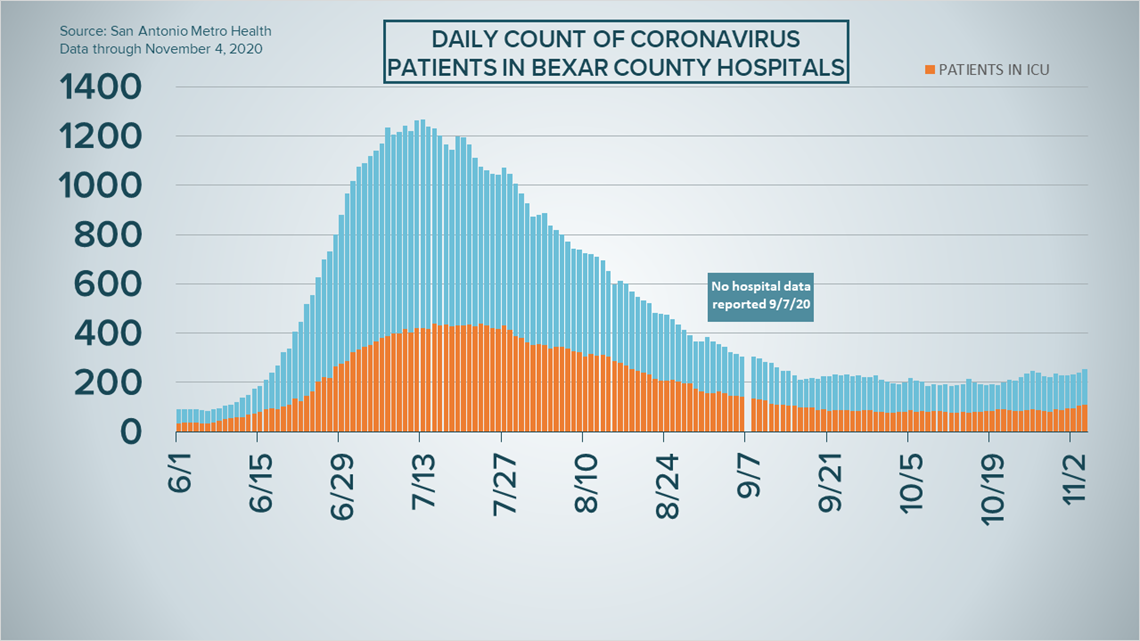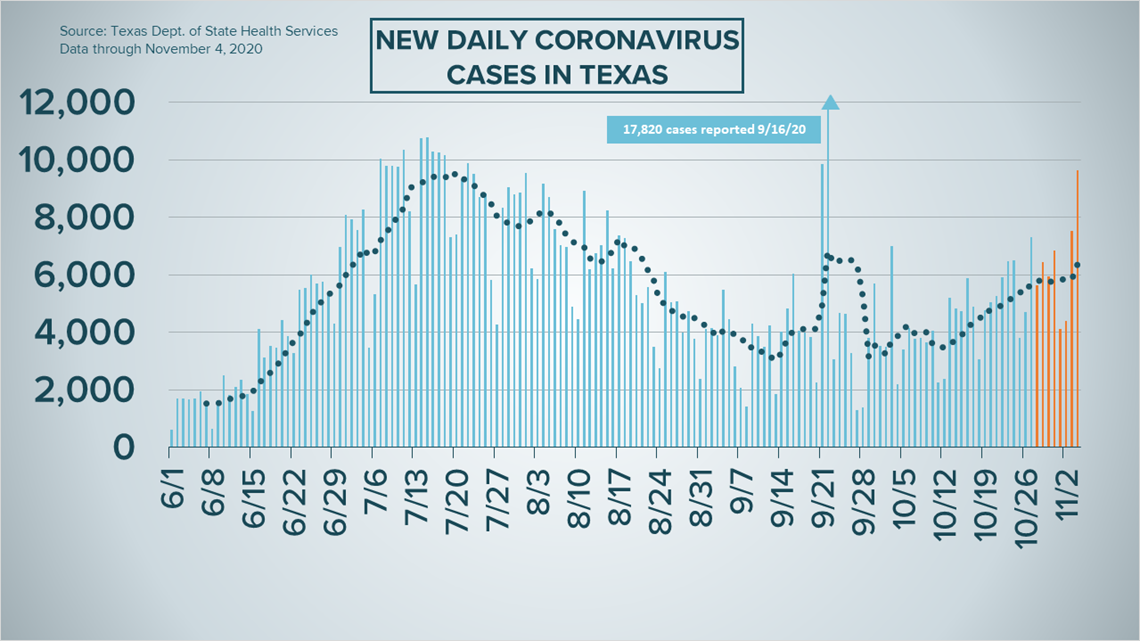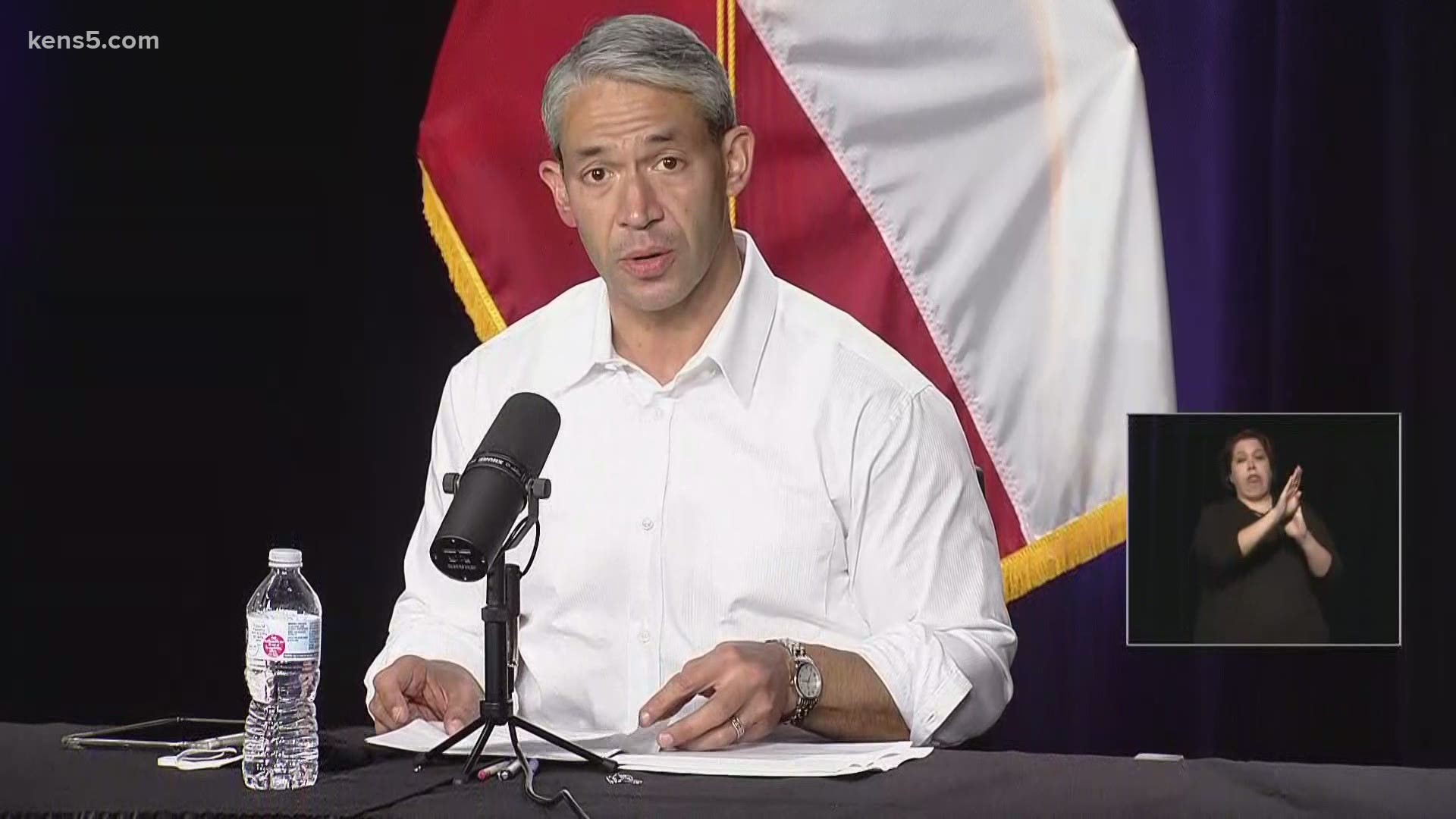SAN ANTONIO — We're tracking the latest numbers from the coronavirus pandemic in San Antonio and across Texas. Here are the latest numbers reported by Bexar and surrounding counties:
- Bexar County: 185 new cases were reported Wednesday, bringing the total number of cases for the county to 66,714. Five new deaths were reported, raising the death toll to 1,265.
- Comal County: The county reported 19 new COVID-19 cases Wednesday morning, as well as one backlogged diagnosis. One new virus-related death was also reported. There have been a total of 3,845 reported cases of COVID-19 in the county – including 2,906 lab-confirmed cases – while 121 county residents have died. County officials say there are 132 active coronavirus cases, and 3,591 residents are considered recovered.
- Hays County: Officials in Hays County on Wednesday reported 34 new cases in the county and two additional virus-related deaths. As of Wednesday, there are a total of 6,265 lab-confirmed cases in the county (332 of which are active), while the death toll rose to 91. 5,842 residents have recovered from the virus.
How Bexar County is trending
We've tracked how many coronavirus cases have been confirmed in Bexar County from the time officials began reporting cases in March 2020. The graphic below shows the number of cases since June and charts those daily case numbers along a 7-day moving average to provide a more accurate picture of the overall coronavirus case curve in our area and the direction we're trending amid the pandemic.
On Wednesday, Mayor Ron Nirenberg reported an additional 185 coronavirus cases in Bexar County, bringing the total number of local diagnoses to 66,714 since the pandemic began.
Nirenberg also reported five new deaths in the county from virus complications. In all, 1,265 Bexar County residents died after contracting the virus.


Hospitalizations in the area, meanwhile, are at their highest levels in weeks. On Wednesday, 255 county residents were receiving treatment for COVID-19 symptoms while 110 of them were in intensive care; Sept. 12 was the last time both numbers were that high.
The number of patients using ventilators also increased by 10 over Tuesday, to 56.


Coronavirus in Texas
The number of Texans who have tested positive for the coronavirus since the pandemic began grew by 9,627 on Wednesday, according to the Texas Department of State Health Services.
9,049 of those are new diagnoses over the last 24 hours – the largest pool of new Texas cases since August 1 – while another 578 cases stem from a number of backlogs in several counties. More details can be found at the top of this page.
As of Wednesday, at least 926,400 Texans have contracted COVID-19.


State health authorities also reported 126 additional virus-related deaths on Wednesday. At least 18,320 Texans have passed away from COVID-19 complications.
5,872 Texans are currently receiving treatment for COVID-19 symptoms—64 fewer patients overall than on Tuesday. The start of November has, thus far, continued October's troubling trend of resurgent virus spread and increasing hospitalizations from the coronavirus in the Lone Star State. Since Oct. 1, hospital admissions from the virus have gone up 84%.
Experts attribute the recent spike in COVID-19 numbers to "pandemic fatigue."
The state estimates that 797,586 Texans have recovered, while 112,776 Texans remain ill with COVID-19.
Meanwhile, the latest update from the Texas Education Agency showed that there have been 26,127 cumulative cases among staff and students across the state through Oct. 25. More information can be found here.
The TEA releases new data on school cases every Thursday.
Latest Coronavirus Headlines
- New book teaches kids about coronavirus
- El Paso reports more than 3,000 new COVID-19 cases in a single day, shattering previous record
- New methods to treat coronavirus patients | Wear the Gown
- City offers several options to help people struggling during the pandemic
- Does weather affect the spread of the coronavirus outside?
- Socially distant 'micro-weddings' in vogue during coronavirus pandemic
- Crushed by the coronavirus, 2 mall operators file for bankruptcy
- President Trump suggests he might be firing Dr. Fauci after election
Coronavirus symptoms
The symptoms of coronavirus can be similar to the flu or a bad cold. Symptoms include fever or chills, cough, shortness of breath or difficulty breathing, fatigue, muscle or body aches, headache, new loss of taste or smell sore throat, congestion or runny nose, nausea or vomiting and diarrhea, according to the Centers for Disease Control.
Most healthy people will have mild symptoms. A study of more than 72,000 patients by the Centers for Disease Control in China showed 80 percent of the cases there were mild.
But infections can cause pneumonia, severe acute respiratory syndrome, kidney failure, and even death, according to the World Health Organization. Older people with underlying health conditions are most at risk.
But infections can cause pneumonia, severe acute respiratory syndrome, kidney failure, and even death, according to the World Health Organization. Older people with underlying health conditions are most at risk.
Experts determined there was consistent evidence these conditions increase a person's risk, regardless of age:
- Chronic kidney disease
- COPD (chronic obstructive pulmonary disease)
- Obesity (BMI of 30 or higher)
- Immunocompromised state (weakened immune system) from solid organ transplant
- Serious heart conditions, such as heart failure, coronary artery disease, or cardiomyopathies
- Sickle cell disease
- Type 2 diabetes
The CDC believes symptoms may appear anywhere from two to 14 days after being exposed.
Human coronaviruses are usually spread...
- Between people who are in close contact with one another (within about 6 feet).
- Through respiratory droplets produced when an infected person coughs, sneezes or talks. These droplets can land in the mouths or noses of people who are nearby or possibly be inhaled into the lungs.
- Some recent studies have suggested that COVID-19 may be spread by people who are not showing symptoms.
Help stop the spread of coronavirus
- Stay home when you are sick.
- Eat and sleep separately from your family members
- Use different utensils and dishes
- Cover your cough or sneeze with your arm, not your hand.
- If you use a tissue, throw it in the trash.

